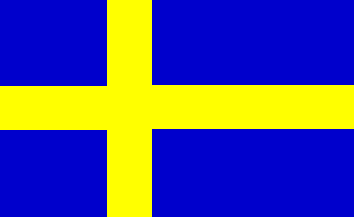 |
SWEDEN |
Part 4 |
 |
SWEDEN |
Part 4 |
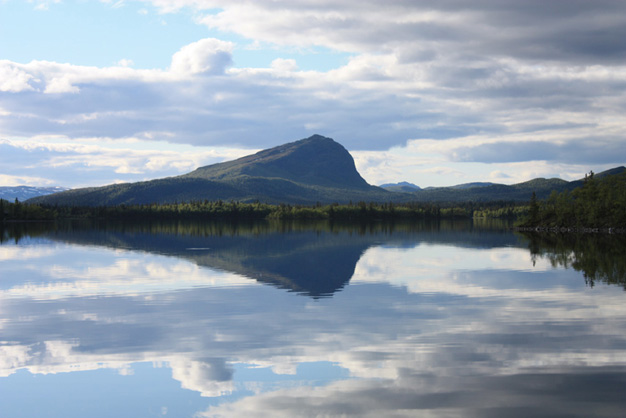 magnificent lake infront of our door step. After breakfast we go and do some canooing. We
get peddles and life vests. Unfortunately the wind has picked up speed and the
waves on the lake become higher. Here and there we some white water. Still we
charge on, but after an hour or so we call it a day. Maybe it will get better
later in the day. We take a break and go for lunch. After lunch we do a walk in
the surrounding area and at 3.30pm our herbal bath and massage is due. A
wonderful experience. At 5.30 we go for dinner. It is still very quiet, but
there are two other tables taken by guests. There is a choice between a buffet
or a la carte. We choose a la cart. I take the Souvas, a dish with reindeer meat
in delicious soauce and pressed patatoes.
magnificent lake infront of our door step. After breakfast we go and do some canooing. We
get peddles and life vests. Unfortunately the wind has picked up speed and the
waves on the lake become higher. Here and there we some white water. Still we
charge on, but after an hour or so we call it a day. Maybe it will get better
later in the day. We take a break and go for lunch. After lunch we do a walk in
the surrounding area and at 3.30pm our herbal bath and massage is due. A
wonderful experience. At 5.30 we go for dinner. It is still very quiet, but
there are two other tables taken by guests. There is a choice between a buffet
or a la carte. We choose a la cart. I take the Souvas, a dish with reindeer meat
in delicious soauce and pressed patatoes.
The wind has not stopped and we give up on our plan to have another go at canooing. We watch football on tv instead.: Conferderations Cup, Egypt vs Italy.
Weather: cloudy with sunny spells. Windy. 9º / 48ºF.
We move on towards Umeå.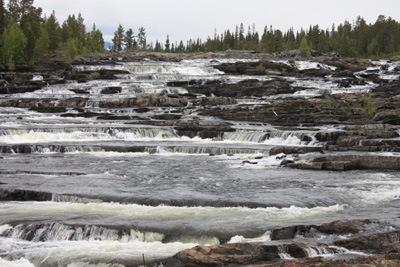 A longish drive of more than 300km. Within a few kilometres we stop already to
have a look at some nice rapids. After some snapshots we quickly move on to Vilhelmina.
We get there within an hour and have some coffee there in the aptly named hotel
Wilhelmina. The local bakery is closed on midsummer eve and midsummer day. We go
to the local church district. Wooden houses along the Church Road. It is raining
unfortunately. We fill our tank and take out money. For the first time in three
days we are back in civilsation again. We carry on to Lyksele. That is a
regional cnetre, but on a midsummer eve it is practically dead. Some shops are
open, but only just and they will close by noon. We have some lunch in a bakery:
a warm sandwich. We drive on to Umeå.
When we get there we notice how quiet the streets are. We check in at the Scandic Plaza
and get a room on the 11th floor with a fine view of the city and
river banks. It is too late to go to the
A longish drive of more than 300km. Within a few kilometres we stop already to
have a look at some nice rapids. After some snapshots we quickly move on to Vilhelmina.
We get there within an hour and have some coffee there in the aptly named hotel
Wilhelmina. The local bakery is closed on midsummer eve and midsummer day. We go
to the local church district. Wooden houses along the Church Road. It is raining
unfortunately. We fill our tank and take out money. For the first time in three
days we are back in civilsation again. We carry on to Lyksele. That is a
regional cnetre, but on a midsummer eve it is practically dead. Some shops are
open, but only just and they will close by noon. We have some lunch in a bakery:
a warm sandwich. We drive on to Umeå.
When we get there we notice how quiet the streets are. We check in at the Scandic Plaza
and get a room on the 11th floor with a fine view of the city and
river banks. It is too late to go to the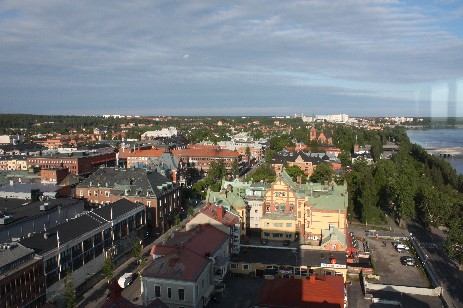 open air museum for the midsummer festivities. But when we go out on the street
at 4pm we see that the city is practically empty. All shops and restaurants have
closed with the exeption of the hamburger stand. It is very sad. Umeå is a town
of over 100,000 inhabitants, but today (and tomorrow) they all seem to have
left. Some businesses are even closed until Tuesday. Even the cinema and the
Chinese take-away are closed. Unbelievable. There is still a branch of Wayne’s
coffee (the Swedish answer to Starbucks), that is open. We drink a cup with
a nice cake out on their sundeck. The weather is fantastic today. The sun is
shining and sheltered from the wind it is delightful. We stroll on and discover
to our surprise and joy that one restaurant on boat in the river is open as
usual. Well not as usual. They have set aside the menu and we have to
choose between a buffet or Today's Special. We do it and it tastes good too.
Including the wine it sets us back 570 kronor for both of us. Back at the hotel
we see some of European Championships for football teams under 21 and some
midsummer blabla on TV. Later in the evening we go out again for a drink on the
same boat, the Sjöbris.
Most of the guests have now gone and the local alholics have taken their places.
We drink up and have another walk through the deserted town centre. At the
reception we are told that the hotel restaurant and bar will be open
tomorrow. Huray!!
open air museum for the midsummer festivities. But when we go out on the street
at 4pm we see that the city is practically empty. All shops and restaurants have
closed with the exeption of the hamburger stand. It is very sad. Umeå is a town
of over 100,000 inhabitants, but today (and tomorrow) they all seem to have
left. Some businesses are even closed until Tuesday. Even the cinema and the
Chinese take-away are closed. Unbelievable. There is still a branch of Wayne’s
coffee (the Swedish answer to Starbucks), that is open. We drink a cup with
a nice cake out on their sundeck. The weather is fantastic today. The sun is
shining and sheltered from the wind it is delightful. We stroll on and discover
to our surprise and joy that one restaurant on boat in the river is open as
usual. Well not as usual. They have set aside the menu and we have to
choose between a buffet or Today's Special. We do it and it tastes good too.
Including the wine it sets us back 570 kronor for both of us. Back at the hotel
we see some of European Championships for football teams under 21 and some
midsummer blabla on TV. Later in the evening we go out again for a drink on the
same boat, the Sjöbris.
Most of the guests have now gone and the local alholics have taken their places.
We drink up and have another walk through the deserted town centre. At the
reception we are told that the hotel restaurant and bar will be open
tomorrow. Huray!!
Weather: 15º / 60ºF.and sunny
It is a little bit cloudy when we get up, but gets brighter. We have breakfast in hotel restaurant and then take the car for a drive out to Norrbyskär. On the way there we wash the car. It has become quite dirty by now. After that we drive about 30km south. When we leave the motorway we get onto an dirt road and the car is as dirty as it was before we had it washed. We park the car in Norbyn near there ferry landing. The ferry leaves at 10.30am and takes only passengers and no cars. The Norbyn archipellago was bought in the late 19th century by Frans Kempe, son of family of wood merchants and saw mill owners. in Mo and D
 omsjö
down south. Kempe got to know of the islands by accident, which were discarded by
the local farmers as useless. The farmers were happy to sell. For Kempe they
were ideal as a base for a timbermill processing trees that were grown upstream
and were transported to the coast via rivers like the Ume. The invention of the
steam engine made it possible to saw and cut the wood on the coast, in stead of
upstream by waterpower. On the islands he built sawmills and the bays between
the islands were used as natural storage. On the islands he also built a
settlement for his workforce, which he paid well and provided with health care,
education, pension, entertainment etc. The workforce was involved via a workers
council. This way Kempe managed to keep labour unions outside until 1919. The
mill closed down in 1953, but ten year after its closure people were still
employed for winding down the operation. The settlement is still there as
are some community buildings and one production hall. There is miniature
settlement for children, a museum and a well made scale model of the settlement
and mil in its heyday. There is also a church and a YMCA. The main building
houses a hotel and restaurant. We walk around the islands interconnected by
dams. The workers cottages are now used as summer homes. We have lunch in the
main building. A delicious buffet lunch with salmon, hering and various other
dishes. The sun has come out, there is no wind and it is lovely out here.
omsjö
down south. Kempe got to know of the islands by accident, which were discarded by
the local farmers as useless. The farmers were happy to sell. For Kempe they
were ideal as a base for a timbermill processing trees that were grown upstream
and were transported to the coast via rivers like the Ume. The invention of the
steam engine made it possible to saw and cut the wood on the coast, in stead of
upstream by waterpower. On the islands he built sawmills and the bays between
the islands were used as natural storage. On the islands he also built a
settlement for his workforce, which he paid well and provided with health care,
education, pension, entertainment etc. The workforce was involved via a workers
council. This way Kempe managed to keep labour unions outside until 1919. The
mill closed down in 1953, but ten year after its closure people were still
employed for winding down the operation. The settlement is still there as
are some community buildings and one production hall. There is miniature
settlement for children, a museum and a well made scale model of the settlement
and mil in its heyday. There is also a church and a YMCA. The main building
houses a hotel and restaurant. We walk around the islands interconnected by
dams. The workers cottages are now used as summer homes. We have lunch in the
main building. A delicious buffet lunch with salmon, hering and various other
dishes. The sun has come out, there is no wind and it is lovely out here.
We take the 14.15 ferry back to the main land. We drive back to Umeå for a visit to the Gammlia museum. When we arrive in Umeå it start pouring down with rain. That is why we give the open air part of Gammlia a miss and have a look at the image museum (not so interesting) and a part of the regional Västerbottenmuseum (museum of West Bothnia), where we see photos by a local photographer who alternated between social historical documentation with foreign new reports of e.g. the Prague Spring of 1968. There is also an exhibition on East Bothnia, the province across the Gulf of Bothnia, that use to be part of Sweden, but is now Finnish as a result of the defeat of Sweden by Russia in 1809, now 200 years ago.
The sun comes back as we drive back to the hotel. I take a sauna on the 14th floor of the hotel. It has a wonderful view over town. In the sauna cabin itself is also a large viewing window.
From the sauna I can see that restaurant Rex has opened its outside tables in the sun and we decide to for it. We have pre dinner drinks and stay on for dinner. It turns out to be very tasteful. I take a bass fillet and Erik an entrecote.
Back in the hotel we watch Spain beat South Africa for the Conferations Cup.
Weather: sunny 15º / 60ºF; afternoon shower
We drive south and stop for coffee in Örnsköldsvik.
The town is deserted on a Sunday morning. We head for the First Hotell on the deserted docks of the town and ask
if we can have a cup. We can do so free of charge. We take a seat on the terrace
adjoing the restaurant in the morning sun. We drive on and arrive an hour later
in Härnösand. We head straight for the Youth
Hostel, which appears to be closed. We ring the phone number posted on
the door and get the warden on the line. She gives us the door code so that we
can go in. We can leave our bags in a room. Our won room will be ready in an
hour. We walk into town and have lunch at Rutiga Dukan, a small lunch café. We
walk back to the Hostel and our room is ready. Spacious room, but toilet and
shower are communal.
morning. We head for the First Hotell on the deserted docks of the town and ask
if we can have a cup. We can do so free of charge. We take a seat on the terrace
adjoing the restaurant in the morning sun. We drive on and arrive an hour later
in Härnösand. We head straight for the Youth
Hostel, which appears to be closed. We ring the phone number posted on
the door and get the warden on the line. She gives us the door code so that we
can go in. We can leave our bags in a room. Our won room will be ready in an
hour. We walk into town and have lunch at Rutiga Dukan, a small lunch café. We
walk back to the Hostel and our room is ready. Spacious room, but toilet and
shower are communal.
In the afternoon we explore the compact
town centre of Härnösand. On the big square is the former neoclassical
governors mansion. On the same square is also the former provincial
adminstration, now serving as museum and tourist offfice. Both are closed on
Sundays. The Neoclassical kathedral is the smalles in Sweden. It was built in
1840. The baroque altarpiece is 18th century. On Nybrogatan are the town hall -
undergoing repairs - and an art nouveau building housing provincial government
these days. At the top of the wide and steadily climbing street stands the
Student Union building. From its front lawn there is a nice view of the town
centre. Behind the Youth Hostel lies the Östanbackan neighbourhood. It is one
of the oldest districts in town. It has typical wooden houses 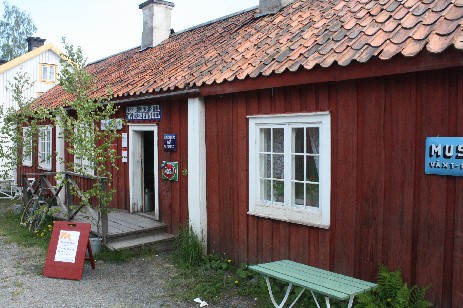 along
narrow coblestone alleyways. Around 1730 this was the first part of town that
was rebuilt after Russian incursions.
along
narrow coblestone alleyways. Around 1730 this was the first part of town that
was rebuilt after Russian incursions.
After seeing the town we drive to the big open air museum Murberget, the second biggest in the country, after Skansen in Stockholm. It is open (free) and some of the houses are manned with people in period costumes. Especially the warden of the grocery store is very proud of it all. After having visited part of the museum we buy some traditional sweets in his historical shop. We then head for the beach. The coast is lined with summer houses on private grounds. We accidentally park on someones private parking lot, but not for long. The owner storms out of his house to point out our grievous error. We drive on to a public parking space. The beach is a pebble beach. It has been sunny all day and temperature has risen to around 20 degrees Celsius (68 Fahrenheit).
At night we have a beer neer the port (Sam’s Pub) and then try to find a restaurant. We end up at Matverkstad. Nothing special, and inexpensive. It is also frequented by some local alcoholics, but they do not bother us. We return to the hostel and watch Brazil walking over Italy, knocking the Italians - to their surprise and dismay - out of the competition in favour of the USA.
Weather: sunny, 20º / 68ºF
| Other Travel | ||
| back | continue |